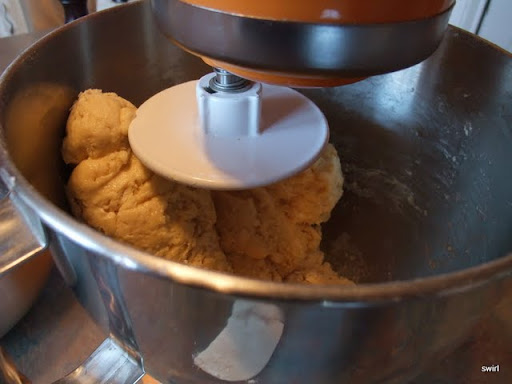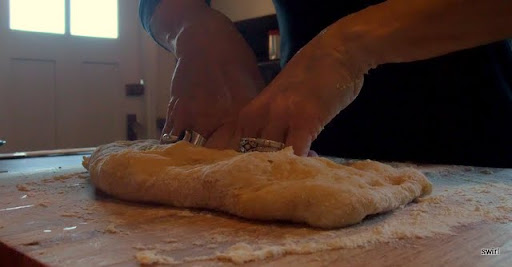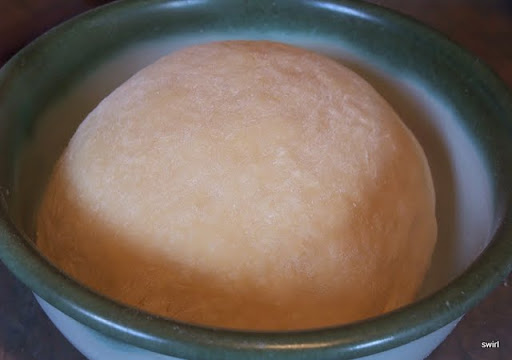Time to Make the Pasta!
Beth Ribblett
Step 1: Make the soffritto
Step 2: Make the ragu
Step 3: Make the dough
True Italian Lasagna, not the cheesy, saucy stuff we make here in the US, is a very involved process. It all starts with a soffritto, followed by a meat ragu and if you REALLY like the people you are cooking for, you make the pasta. It is the only way to achieve the thin, thin layers that melt in your mouth and help give the lasagna its light texture. But it is a labor of love that takes patience and proper timing.
So we've already made the soffritto, and from that a delicious ragu is bubbling on the stove. Next we'll make the dough and as it is resting, we'll make the besciamella, then roll out and quickly blanch the pasta noodles and start to assemble the lasagna.
On to the dough. I have two pasta dough recipes that I use on a regular basis, one is from Lidia Bastianich, the other is from Francis Mayes. I like them both equally as much, but when I made the lasagna I used Frances Mayes and I thought the texture and pliability of this dough was ideal for achieving the thin sheets needed for this dish. The ingredients vary ever so slightly and the process is the same. I use a kitchen aid mixer for the initial blending, kneed the dough by hand and after it has rested I use the pasta attachment for my mixer to roll the sheets.
In this post I'll take you to the point where the dough is resting, before you roll it. While it is resting, we'll start the besciamella.
Click here Lidia's recipe.
 Frances Mayes Basic Pasta
Frances Mayes Basic Pasta
Ingredients for 1lb. of pasta
2-1/2 cups of all purpose flour, plus additional for kneading
3 eggs
1 t. salt
2 t. extra virgin olive oil
1 to 2 T. water, plus additional if needed
Directions
In a small bowl, beat the eggs, salt, olive oil and 1 T. of the water. Place your flour in the mixer bowl and put on the dough hook attachment. With the mixer on low speed, pour the egg mixture into the mixing bowl. Mix just until the mixture comes together to form a rough dough. If the dough seems to dry, drizzle a very small amount of water into the bowl.

Remove the dough from the bowl and knead using the remaining flour, and more if necessary, using the following method.Once you have formed a rough dough, it is ready to knead. Flour a marble or wooden work surface. Press the heel of one handing deep into the dough, keeping your fingers high. Then press down on the dough while pushing it firmly away from you-the dough will stretch and roll under your hand like a large shell. Turn the dough over, then press into the dough first with the knuckles of one hand, then with the other; do this about ten times with the knuckles of each hand. Use the knuckles of your forefingers especially during this process.

Then repeat the stretching and "knuckling" process, using more flour if needed to prevent sticking, until the dough is smooth and silky, 10-20 minutes. Roll the dough into a smooth ball. Cover the dough with a damp dishtowel and let it rest for at least 1 hour at room temperature, or up to 1 day in the refrigerator, before rolling and shaping the pasta. If the dough has been refrigerated, let it stand at room temperature for at least 1 hour before rolling and shaping.

So, while the dough is resting we can make the besciamella. I'll post that recipe tomorrow!
Step 2: Make the ragu
Step 3: Make the dough
True Italian Lasagna, not the cheesy, saucy stuff we make here in the US, is a very involved process. It all starts with a soffritto, followed by a meat ragu and if you REALLY like the people you are cooking for, you make the pasta. It is the only way to achieve the thin, thin layers that melt in your mouth and help give the lasagna its light texture. But it is a labor of love that takes patience and proper timing.
So we've already made the soffritto, and from that a delicious ragu is bubbling on the stove. Next we'll make the dough and as it is resting, we'll make the besciamella, then roll out and quickly blanch the pasta noodles and start to assemble the lasagna.
On to the dough. I have two pasta dough recipes that I use on a regular basis, one is from Lidia Bastianich, the other is from Francis Mayes. I like them both equally as much, but when I made the lasagna I used Frances Mayes and I thought the texture and pliability of this dough was ideal for achieving the thin sheets needed for this dish. The ingredients vary ever so slightly and the process is the same. I use a kitchen aid mixer for the initial blending, kneed the dough by hand and after it has rested I use the pasta attachment for my mixer to roll the sheets.
In this post I'll take you to the point where the dough is resting, before you roll it. While it is resting, we'll start the besciamella.
Click here Lidia's recipe.
Ingredients for 1lb. of pasta
2-1/2 cups of all purpose flour, plus additional for kneading
3 eggs
1 t. salt
2 t. extra virgin olive oil
1 to 2 T. water, plus additional if needed
Directions
In a small bowl, beat the eggs, salt, olive oil and 1 T. of the water. Place your flour in the mixer bowl and put on the dough hook attachment. With the mixer on low speed, pour the egg mixture into the mixing bowl. Mix just until the mixture comes together to form a rough dough. If the dough seems to dry, drizzle a very small amount of water into the bowl.
Remove the dough from the bowl and knead using the remaining flour, and more if necessary, using the following method.Once you have formed a rough dough, it is ready to knead. Flour a marble or wooden work surface. Press the heel of one handing deep into the dough, keeping your fingers high. Then press down on the dough while pushing it firmly away from you-the dough will stretch and roll under your hand like a large shell. Turn the dough over, then press into the dough first with the knuckles of one hand, then with the other; do this about ten times with the knuckles of each hand. Use the knuckles of your forefingers especially during this process.
Then repeat the stretching and "knuckling" process, using more flour if needed to prevent sticking, until the dough is smooth and silky, 10-20 minutes. Roll the dough into a smooth ball. Cover the dough with a damp dishtowel and let it rest for at least 1 hour at room temperature, or up to 1 day in the refrigerator, before rolling and shaping the pasta. If the dough has been refrigerated, let it stand at room temperature for at least 1 hour before rolling and shaping.
So, while the dough is resting we can make the besciamella. I'll post that recipe tomorrow!
